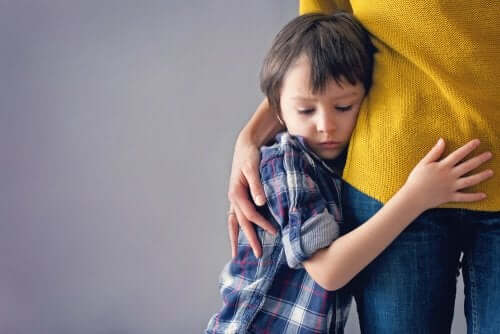How to Reduce Anxiety in Children

Anxiety is a normal response to something that you think is a danger or threat. When someone experiences exaggerated fear, we think of an anxiety disorder. In today’s article, we’ll be looking at how we can help reduce anxiety in children.
Join us to find out more about childhood anxiety, what the symptoms are, and the best tips to help children cope with anxiety to prevent a psychological disorder from forming.
What is anxiety?

Children begin to experience fears that can create anxiety around two or three years old. Does a monster live under the bed? What would happen if my parents died? What if a thief entered the house?
Even riding a bike and being afraid of falling can create anxiety. However, there is a clear problem when that feeling is so strong, and so excessive, that it becomes a disorder.
Symptoms of anxiety in children

For children who can’t manage their many fears, anxiety can quickly become an unwanted companion. Let’s look at the possible symptoms of anxiety in children:
- Frequent headaches or stomach aches without a medical reason
- Tense muscles, trembling or excessive sweating
- Sleeping difficulties: either trouble falling asleep (also called insomnia) or trouble getting up
- Extreme sensitivity and crying
- Anger for no apparent reason
- Irritable moods
- Excessive fear of making mistakes
- Panic attacks
- Phobias and exaggerated fears: for example, your child might be afraid of an animal or natural phenomenon, like a hurricane
- Fear of not being loved
- Restlessness and constant nervousness
- Your child doesn’t want to go to school. Also, they might not want to eat there or use the school bathroom
- Seeks constant approval of their parents
- Constantly asks questions like “What would happen if…?”
- Feels like they can’t do things that they haven’t already tried.
As you can see, these symptoms overlap with other problems. For example, it could be a result of bullying. If you think your child suffers from anxiety, don’t hesitate to consult your doctor, and they’ll give a diagnosis.
You might be interested: 5 Simple Ways to Stop a Panic Attack
Anxiety disorders
Anxiety can become a disorder. Some of the most common disorders are:
- Phobias: The child feels an extreme or irrational fear or something, an animal or situation. For example, he might be afraid of insects or going to the doctor.
- Separation anxiety: The child is afraid to leave their parents.
- Social anxiety: The child becomes anxious when they have to go to a place with lots of people, like school or the mall.
- Panic disorder: The child sweats, feels dizzy and shaky. In addition, they have trouble breathing and their heart races when they feel afraid.
- General anxiety: The child worries about everything around them.
Tips to reduce anxiety in children
1. Help your child face their fears

Your first reaction as a parent is probably to avoid activities that give your child anxiety. Don’t do it! Your child must learn to face their fears. Otherwise, they’ll avoid the problem and prolong their anxiety over time.
2. Lead by example
Children watch their parents to gauge how to act in different situations. Show them that you know how to control your emotions, even when you feel anxious. Be the mirror for your child to look at!
3. Talk to your child to help reduce anxiety
If you know that your child will have to face a situation that makes them anxious, talk to them beforehand. Not knowing what to do is different from not knowing the cause. Therefore, knowing ahead of time what will happen can help reduce anxiety in children.
Don’t miss out: Mental Illness in Children and Its Symptoms
4. Show your feelings

To reduce anxiety, it’s important to show empathy. That is, listen to your child without judging them. So, to get your child to trust you, you can open your heart and talk about your experiences. Also, sharing your emotions with them will make your child more likely to share with you.
5. Congratulate your child
Accompany your child on the path of overcoming anxiety. Then, congratulate them on each small step they take towards overcoming their fears.
6. Show your support and love
Your support and love should be unconditional. Make sure your child understands that! There’s nothing more important for your little one than knowing that you’re always on their side, no matter what happens.
7. Gently correct them

Don’t hesitate to correct your child’s actions, without labeling their personality. Remember, it’s important to be able to talk about their performance, even giving constructive criticism. However, don’t label anxiety as a personality trait.
8. Seek professional help
If your child’s anxiety gets bad enough to the extent that they can’t have a normal life, then don’t hesitate to go to the doctor. Then, a psychologist will help them face their fears and find the source of them.
Anxiety in children is more common than you might think. Like us, kids feel threatened by their surroundings sometimes. Uncertainty creates fear, and we’ve definitely all been through it. The important thing is to learn to manage fear and not let it control you.
All cited sources were thoroughly reviewed by our team to ensure their quality, reliability, currency, and validity. The bibliography of this article was considered reliable and of academic or scientific accuracy.
- Valiente, R. M., Sandín, B., & Chorot, P. (2002). Miedos comunes en niños y adolescentes: Relación con la sensibilidad a la ansiedad, el rasgo de ansiedad, la afectividad negativa y la depresión. Revista de psicopatología y Psicología clínica, 7(1), 61-70. http://revistas.uned.es/index.php/RPPC/article/view/3922
- Cárdenas, E. M., Feria, M., Palacios, L., & De la Peña, F. (2010). Guía clínica para los trastornos de ansiedad en niños y adolescentes. México: Instituto Nacional de Psiquiatría Ramón de la Fuente y Secretaría de Salud. http://inprf-cd.gob.mx/guiasclinicas/trastornos_de_ansiedad.pdf
- MedlinePlus staff. (n.d.). Trastornos del pánico. MedlinePlus. https://medlineplus.gov/spanish/panicdisorder.html
This text is provided for informational purposes only and does not replace consultation with a professional. If in doubt, consult your specialist.








